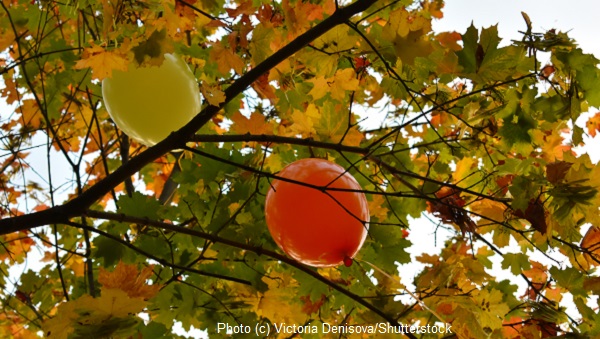
What Goes Up Must Come Down -
The Problem With Balloons
By Wendy Priesnitz
Birthdays, births, graduations, promotions, anniversaries, Valentine’s Day, retirements, sporting events…. Balloons are used to decorate and celebrate many life events. Sometimes, they’re tied to a weight or bouquet of flowers and remain indoors until they slowly deflate as the celebration ends. Other times, they’re carried proudly by little children on a summer day, only to waft away to the accompaniment of tears. And sometimes, large numbers – often thousands – of them are actively released outdoors in special shows of lofty exuberance.
But what goes up must come down. And in the case of balloons, that results in plastic litter that is potentially deadly. Once released into the air during celebrations, balloons and their fragments make their ways into rivers, lakes, and oceans, hurting or killing marine mammals in the process. Not just marine mammals are at risk; fish, birds, and land animals (both wild and domestic) also mistake them for food and/or get tangled in their strings. The victim is usually killed as a result of the balloon blocking its digestive tract, leaving it unable to take in any more nutrients and slowly starving it to death.
A 2016 study conducted for the international group Ocean Conservancy and published in the journal Marine Policy, ranked balloons as one of the top three deadliest forms of litter, only behind discarded fishing nets and plastic bags.
Seabirds are particularly vulnerable. The research found that balloons are the highest-risk plastic debris item for seabirds. Marine birds are 32 times as likely to die from eating a little fragment of a popped balloon than they are from a hard plastic like a LEGO brick or straw. Even though balloons represent only two percent of all plastics ingested by seabirds, they are responsible for 42 percent of plastic-related deaths.
The problem is huge and occurs worldwide. Balloons with notes that were released by school children in the UK were found as far away as Australia. According to the U.S. environmental non-profit group Alliance for the Great Lakes, volunteer shoreline cleanups found more than 18,000 balloons and balloon pieces on Great Lakes beaches alone between 2016 and 2018. In 2019 the International Coastal Cleanup, an annual event organized by the Ocean Conservancy, recorded over 100,000 balloons found around the world, with almost half in the U.S.
A few U.S. states have laws regulating the intentional release of balloons, with others considering such laws, and a number of countries around the world have done the same. Some cities also have ordinances against intentional balloon releases.
Not surprisingly, the balloon industry dislikes talk about banning balloons. The Balloon Council, a Trenton, New Jersey-based organization of balloon retailers, distributors, and manufacturers, spends millions of dollars lobbying to change or stop proposed laws to restrict balloons.
The industry markets latex balloons as biodegradable, with the insinuation that they’re eco-friendly. However, latex balloons are the kind found most often in the stomachs of dead animals.
In response to industry greenwashing and the popularity of balloon releases, two 20-something American sisters formed a non-profit organization called Balloons Blow. Their website and social media accounts provide a wealth of information about the problem.
Balloons Blow also notes that balloons are also a waste of helium, which is a finite resource and can be put to other, more important uses in the fields of science and medicine. In addition, mylar balloons entangled in electrical transmission equipment can cause power outages.
Fortunately, alternatives are as available as one’s imagination. Consider garden spinners and pinwheels; flags, banners, ribbon dancers, origami garlands, and kites; tissue paper pompoms that can be thrown into the compost when you’re done; solar-powered lamps and battery-operated strings of colored lights; flowers; blowing bubbles; or floating flowers down a calm stream (to replace balloon releases sometimes used at funerals).
Wendy Priesnitz is Natural Life Magazine's editor. She has been a journalist for over forty years and is the author of thirteen books.
|

